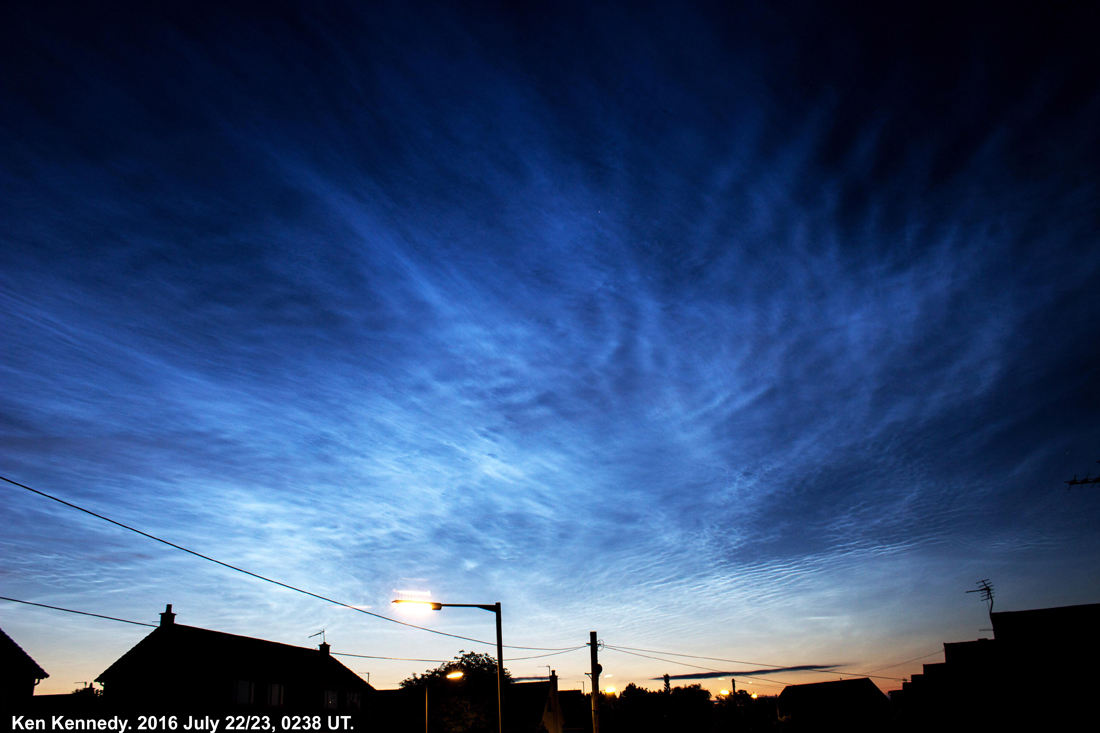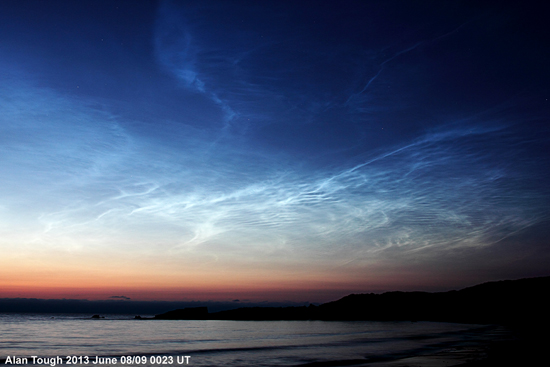Dundee Astronomical Society has been joining us at various open days for some years and has a small observatory in the Living Field garden. Ken Kennedy kindly sent us this article on noctilucent clouds for the Living Field web site.
We all hope for a fair bit of sunshine during our northerly summer months but the suggestion that clouds may appear in the summer sky will not be a concept too alien to most of us. However, the clouds I am thinking about are not the cumulous or even stratus type clouds you may well expect on many (well, perhaps most) summer days. In fact these clouds will not be making their appearance during any summer day but could appear an hour or so after the Sun has set and disappear about an hour before sunrise.

On June 8, 1885 Thomas Backhouse in Kissingen, Germany became aware of wispy bluish-white clouds low down towards the north and north-west following a beautiful sunset just a bit earlier in the evening. It had become quite a habit for many people to watch the sunsets and sunrises following the eruption of Krakatoa in August 1883. Many of these were quite spectacular with pink and purple colours which were the result of changes to the light of the setting Sun by particles in the upper atmosphere pushed upwards by the violence of the volcanic eruption. What Backhouse saw on the night of the 8th June, however, was rather different. These clouds were a pearly white, tending towards blue in colour, not the garish colours produced by the volcanic sunsets. It is likely to have been the colourful sunsets which allowed the discovery of these still unusual clouds as a number of historians of astronomy have failed to find any realistic reference to them before 1885.
More reports of sightings of these clouds were made and, as they were seen during the late evening and night, were given the name noctilucent clouds (NLC) or night luminous clouds. Reports and frequency of sightings gradually increased into the 20th century by which time they became a serious curiosity and were creating some questions in the scientific world. It was generally agreed that rising warm air cools and moisture carried by that warm air forms water droplets as the air ascends. These form clouds which could extend upwards to around 15km. Beyond this, very little water could be carried, and certainly not sufficient to form these clouds which had been measured to be at the remarkable height of around 83km. The clouds are formed of ice crystals and are illuminated by the Sun which is between 6 and 16 degrees below the observer’s horizon. James Paton, the then Director of the British Astronomical Association’s Aurora Section made an extensive study of NLC from his home in Abernethy until his death in 1974. Dr Mike Gadsden of Aberdeen University continued to make a detailed study of NLC from the Cromwell Tower of Aberdeen University until his death in 2003. I remember well Mike saying to me ‘These clouds shouldn’t exist. There should not be enough water at that height to allow visible ice clouds’. He also was the first person I heard who suggested that NLC may be a barometer of global atmospheric change (he said this before the phrase ‘global warming’ became popular).
[Continued ……. ]
Ken continues to explain how noctilucent clouds form, describes their role in space science, notably via the findings of the AIM (Aeronomy of Ice in the Mesosphere) satellite and points to the importance of the sun’s cyclic activity (sunspots) on their recorded occurrence. His article can be read in full at the DundeeAstro page on this web site Clouds on the summer horizon. With thanks.


